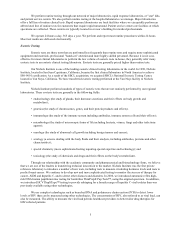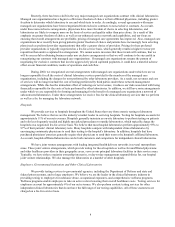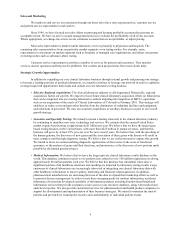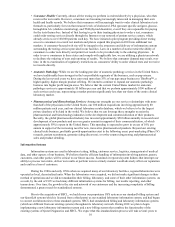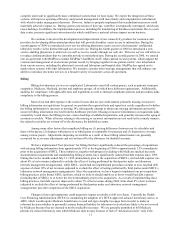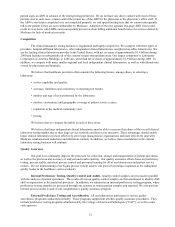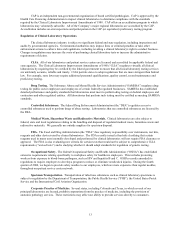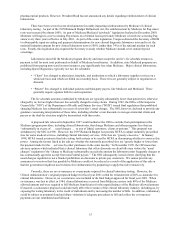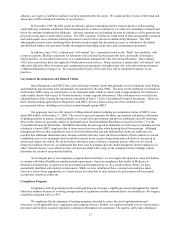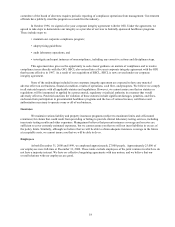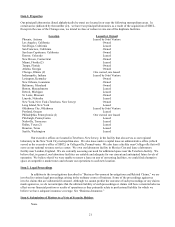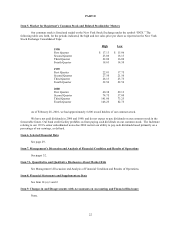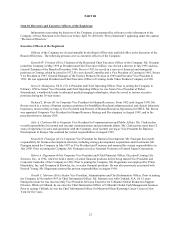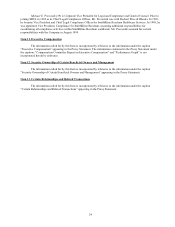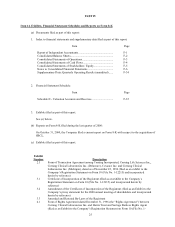Quest Diagnostics 2000 Annual Report Download - page 35
Download and view the complete annual report
Please find page 35 of the 2000 Quest Diagnostics annual report below. You can navigate through the pages in the report by either clicking on the pages listed below, or by using the keyword search tool below to find specific information within the annual report.15
pharmaceutical products. However, President Bush has not announced any details regarding reimbursement of clinical
laboratories.
There have been several recent developments favorably impacting reimbursement by Medicare of clinical
laboratory testing. As part of the 1999 Balanced Budget Refinement Act, the reimbursement by Medicare for Pap smear
tests was increased by almost 100%. As part of Medicare/Medicaid “giveback” legislation finalized in December 2000,
Medicare will begin to cover screening Pap smears on a biennial basis (previously Medicare covered one screening Pap
smear every three years) effective in July 2001. As part of this same legislation, Congress directed the Secretary of HHS
to obtain public input on coding and payment determinations for new clinical diagnostic laboratory tests and to set the
national limitation amount for new clinical laboratory tests at 100% (rather than 74%) of the national median for such
tests. Finally, this legislation also required the Secretary to study whether Medicare should cover routine thyroid
screenings.
Laboratories must bill the Medicare program directly and must accept the carrier’s fee schedule amount as
payment in full for most tests performed on behalf of Medicare beneficiaries. In addition, state Medicaid programs are
prohibited from paying more (and in most instances, pay significantly less) than Medicare. Major clinical laboratories,
including Quest Diagnostics, typically use two fee schedules:
• “Client” fees charged to physicians, hospitals, and institutions to which a laboratory supplies services on a
wholesale basis and which are billed on a monthly basis. These fees are generally subject to negotiation or
discount.
• “Patient” fees charged to individual patients and third-party payers, like Medicare and Medicaid. These
generally require separate bills for each requisition.
The fee schedule amounts established by Medicare are typically substantially lower than patient fees otherwise
charged by us, but are higher than our fees actually charged to many clients. During 1992, the Office of the Inspector
General (the “OIG”) of the Department of Health and Human Services (“HHS”) issued final regulations that prohibited
charging Medicare fees substantially in excess of a provider’s usual charges. The OIG, however, declined to provide any
guidance concerning interpretation of these rules, including whether or not discounts to non-governmental clients and
payers or the dual-fee structure might be inconsistent with these rules.
A proposed rule released in September 1997 would authorize the OIG to exclude from participation in the
Medicare program providers, including clinical laboratories, that charge Medicare and other programs fees that are
“substantially in excess of . . . usual charges . . . to any of [their] customers, clients or patients.” This proposal was
withdrawn by the OIG in 1998. However, the 1997 Balanced Budget Act permits HCFA to adjust statutorily prescribed
fees for some medical services, including clinical laboratory services, if the fees are “grossly excessive.” In January
1998, HCFA issued an interim final rule setting forth criteria to be used by HCFA in determining whether to exercise this
power. Among the factors listed in the rule are whether the statutorily prescribed fees are “grossly higher or lower than
the payment made for the. . . services by other purchasers in the same locality.” In November 1999, the OIG issued an
advisory opinion which indicated that a clinical laboratory that offers discounts on client bills may violate the “usual
charges” regulation if the “charge to Medicare substantially exceeds the amount the laboratory most frequently charges or
has contractually agreed to accept from non-Federal payors.” The OIG subsequently issued a letter clarifying that the
usual charges regulation is not a blanket prohibition on discounts to private pay customers. We cannot provide any
assurances to investors that fees payable by Medicare could not be reduced as a result of the application of this rule or
that the government might not assert claims for reimbursement by purporting to apply this rule retroactively.
Currently, there are no co-insurance or co-payments required for clinical laboratory testing. However, the
Clinton Administration’s original proposed budget for fiscal year 2001 called for reinstatement of 20% co-insurance for
clinical laboratories. However, no co-insurance was included in the final budget approved for fiscal year 2001. When
co-insurance was last in effect in 1984, clinical laboratories received from Medicare carriers only 80% of the Medicare
allowed amount and were required to bill Medicare beneficiaries for the unpaid balance of the Medicare allowed amount.
If enacted, a coinsurance proposal could adversely affect the revenues of the clinical laboratory industry, including us, by
exposing the testing laboratory to the credit of individuals and by increasing the number of bills. In addition, a laboratory
could be subject to potential fraud and abuse violations if adequate procedures to bill and collect the co-insurance
payments are not established and followed.


